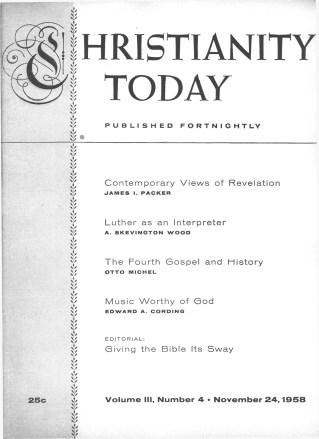The question of biblical interpretation has returned to the centre of theological discussion today. Hermeneutics is no longer relegated to a backroom. It is one of the most prominent preoccupations of the present hour. And in this renascence the name of Martin Luther is much mentioned, for it is being recognized afresh that in a very real sense he is the father of Protestant interpretation. His influence has been widespread and profound. As Professor Kurt Aland has reminded us in a lecture delivered recently at the St. Andrews School of Theology in Scotland, Luther’s interpretation of Scripture has not only left its mark on the theologians and churches of the Lutheran confession for more than four centuries, but is of no less decisive importance for all Protestant communions. In considering Luther’s principles of biblical hermeneutics we are handling one of the vital issues of the hour.
The Bible, of course, was central in the reforming policy of Luther. “As a theologian,” wrote Professor Henry E. Jacobs, “Luther’s chief effort, on the negative side, was to free theology from its bondage to philosophy, and to return to the simplicity of Scripture. He was dissatisfied with technical theological terms because of their inadequacy, even when the elements of truth they contained restrained him from abandoning them. He was not without a historical sense and a reverence for antiquity, provided that it was subjected to the tests of Holy Scripture. Scripture was not to be interpreted by the Fathers, but the Fathers were to be judged by their agreement or disagreement with Scripture” (Article ‘Luther’ in E.R.E. Vol. VIII, p. 201).
Luther’S Experience
We need not traverse yet again the familiar ground of Luther’s rediscovery of the Bible in his personal experience. Suffice it to say that the Reformation really started not on the steps of the Scala Sancta in Rome (where pious legend may have overlaid the tale) nor even at the door of the Castle Church at Wittenberg (where the Ninety-Five Theses were pinned in order to inaugurate a discussion rather than to touch off a revolt), but in the Black Tower of the Augustinian monastery at Erfurt where Luther sat before an open Bible and allowed God to address him face to face. This Turmerlebnis (Tower Discovery) is dated by Schwiebert as “sometime in the fall of 1514” (Luther and His Times, p. 288). Luther himself tells us how he dwelt upon the First Chapter of Romans. “Night and day I pondered until I saw the connection between the justice of God and the statement that ‘the just shall live by faith.’ Then I grasped that the justice of God is that righteousness by which through grace and sheer mercy God justified us through faith. Whereupon I felt myself to be reborn and to have gone through open doors into paradise. The whole of Scripture took on a new meaning and whereas before ‘the justice of God’ had filled me with hate, now it became to me inexpressibly sweet in greater love. The passage of Paul became to me a gate of heaven” (Luther, Werke, Weimar Auflage (W.A.) Vol. LIV, p. 185).
This experience marked the birth of Luther’s doctrine of justification by faith, which was the touchstone by which he tested every theological opinion. But it was cradled in Scripture and, even though Karl Barth takes exception to the expression, we may still rightly affirm that whilst sola fide constitutes the material principle of the Reformation, sola Scriptura is its formal principle. Luther’s “illumination” as he calls it in his Table Talk, or his “inspiration” as Schwarz prefers to denominate it (The Problems of Biblical Translation, p. 169)—that is, his God-given insight into the meaning of Romans 1:17—transformed the whole Bible for him and supplied his overall interpretative clue. His ratiocinative process is evident. As Schwarz has put it: “The meaning of one passage had been revealed to him. He therefore had received the true understanding of this one verse. Holy Writ, being God’s revelation, must of necessity be a unity and its contents be in agreement. It is therefore permissible, or even necessary, to interpret the Bible in accordance with Romans 1:17, if the true meaning of this verse has been revealed” (ibid.). Luther’s entire exegetical output stems from this comprehension, which he recognizes as a gift from God. “I have not dared nor am I able to boast of anything but the Word of truth which the Lord has given me” (Lenker Ed., Vol. II, p. 429).
Scripture Its Own Interpreter
Let us now seek to elaborate some of Luther’s hermeneutical principles arising from his watchwords of sola Scriptura and sola fide. The first is crystallized in the now celebrated phrase Scriptura sui ipsius interpres (W.A. Vol. VII, p. 97). “That is the true method of interpretation,” he says, “which puts Scripture alongside of Scripture in a right and proper way” (Philadelphia Edition (P.E.), Vol. III, p. 334). He seeks to apply the comparative method by setting one portion of the Word beside another and allowing the plainer texts to illuminate the more obscure, as Origen and Augustine had suggested. Luther was convinced of the basic clarity of Scripture. He refused to regard it as a closed book to all but experts. He was persuaded that the humblest believer might read it with spiritual understanding. It was this conviction that led Luther to undertake the translation of the Bible into German—perhaps his greatest monument still. In his Letter on Translating he tells us that his aim was to render the divine message in the language of “the mother in the home, the children on the street, the common man in the market place” (P.E. Vol. V, p. 15). “There is not on earth a book more lucidly written than the Holy Scripture,” he declared. “Compared with all other books, it is as the sun compared with all other lights” (Comm.Ps. 37).
The Word Itself Is Clear
Luther does not deny that some passages of Scripture are hard to understand. But they are so, he argues, “not because they are too high for us, but because of our ignorance of words and grammar” hence his insistence upon a knowledge of the original tongues. But Luther further distinguishes between the intelligibility of the contents of Scripture (evidentia rerum) and the clarity of words (claritas verborum) through which the revealed content is communicated. Mysteries there will always be, for frail reason can never climb up into the divine majesty. The things of God (res Dei) will always be in part incomprehensible to the human mind, but the things of Scripture (res Scripturae) are always clear. Nevertheless, all essential doctrines and precepts are plain to every believer.
Luther does not approve the indiscriminate concatenation of Bible texts without due respect to their meaning and context. He was aware that heretics were fond of such proof, as Irenaeus had complained. “Heretofore I have held that where something was to be proved by the Scriptures,” says Luther, “the Scriptures quoted must really refer to the point at issue. I learn now that it is enough to throw many passages together helter skelter whether they are fit or not. If this is to be the way, then I can easily prove from the Scriptures that beer is better than wine” (W.A. Vol. VI, p. 301). The exegete must keep in view the total teaching of Scripture. “It behoves the theologian, if he would avoid error, to have regard to the whole of Scripture, and compare contraries with contraries” (Opera Latina, Vol. III).
Luther strongly insists upon the primacy of the literal sense. He resolutely sets aside all the verbal jugglery involved in multiple interpretation and firmly takes his stand upon the plain and obvious significance of the Word. “The literal sense of Scripture alone,” he asserts, “is the whole essence of faith and Christian theology” (quoted in F. W. Farrar History of Interpretation, p. 327). And again, “If we wish to handle Scripture aright, our sole effort will be to obtain the one simple, seminal and certain literal sense” (ibid.).
Principles Of Exegesis
Luther believes that every portion of Scripture can be interpreted “in a simple, direct and indisputable way” (P.E. Vol. I, p. 320). He prefers to speak of the grammatical and historical rather than of the literal sense, and fearlessly advances it in the face of his opponents. Nowhere is this more apparent than in his controversy with Jerome Emser, secretary to Duke George of Saxony and Court Chaplain, whom he addressed as the Leipzig Goat. As Steimle has noted, “Luther goes straight to the fundamental difference between them, the sole authority of Holy Scripture in matters of faith and the right exposition of Scripture according to its grammatical sense. Over against Emser’s position, that he would fight with the sword (i.e. the word of Scripture), but that he would not permit it to remain in the scabbard of the word sense, but use the naked blade of the spiritual secret sense, Luther, in the most important section of his answer, under the subtitle ‘The Letter and the Spirit,’ utters the foundation principles of Protestant exegesis” (P.E. Vol. III, pp. 279–280).
But with Luther this is clearly a preference and not an exclusion. Although he urges the primacy of the literal sense, it cannot be said that to sola Scriptura he adds the further principle sola historica sententia, as B. A. Gerrish claims in a recent article (Scottish Journal of Theology, December 1957, p. 346). Indeed the latter goes on to admit that Luther allowed the use of allegory, not as proof, but as ornament and in accordance with the analogia fidei which would accommodate it to Christ, the Church, faith and the ministry of the Word (W.A. Vol. XLII, p. 377). In effect, as Professor Aland brings out, Luther does concede a double meaning of Scripture, just as there is a double obscurity—an outward meaning obtained by the help of the Word and another that lies in the knowledge of the heart. That is why Luther lays so much stress upon the understanding of Scripture by faith. We must feel the words of Scripture in the heart, he says. “Experience is necessary for the understanding of the Word. It is not merely to be repeated or known, but to be lived and felt” (W.A. Vol. XLII, p. 195). Thus, although he is staunchly opposed to all the ‘monkey tricks’ (Affenspielen) of unbridled allegorization, he nevertheless admits a significance in Scripture beyond the strictly literal. The Lutheran dogmaticians elaborated this unsystematized insight into a distinction between the external and internal forma of Scripture. Quenstedt defined it thus: “We must distinguish between the grammatical and outer meaning of the Divine Word and the spiritual, inner and Divine meaning of the Divine Word. The first is the forma of the Word of God insofar as it is a word, the latter is its forma insofar as it is a Divine Word. The first can be grasped even by any unregenerate man, the latter, however, cannot be received except by a mind which has been enlightened” (Theologia, Vol. I, p. 56).
Christ The Key To Scripture
Luther’s interpretation of Scripture is at once Christocentric and Christological. It is Christocentric in that he regards Christ as the heart of the Bible. “Take Christ out of the Scripture and what more is there to find in it?” he asks Erasmus. “Scripture must be interpreted to mean nothing else but that man is nothing, Christ is all” (cf. E. C. Blackman, Biblical Interpretation, p. 117). Christ is “the sun and the truth in Scripture” (W.A. Vol. III, p. 643). Scripture contains “nothing but Christ and the Christian faith” (W.A. Vol. VIII, p. 236). And that assertion obtains for the Old Testament as well as for the New. “Here you will find the swaddling clothes and the manger in which Christ lies. Simple and small are the swaddling clothes, but dear is the treasure Christ that lies in them” (P.E. Vol. VI, p. 368). It might be said, as Blackman suggests, that for Luther Christ is both the literal and the spiritual sense of Scripture and that these two are one in Him (Op. cit., p. 120).
That leads us on to examine the Christological approach of Luther to Scripture, which is determinative for his whole hermeneutical programme. Luther’s recognition of the dual nature of Scripture is one of his most relevant insights. But its precise definition must be carefully observed. He realizes that Scripture is both human and divine, but he does not thereby open the door to the suggestion of fallibility. For he draws a deliberate analogy between Scripture and the person of Christ, between the Word written and the Word incarnate. Orthodox theology enjoins us to hold in tension the humanity and divinity of our Lord. We have to confess that He was both fully man and fully God. It is a heresy to deny either. Docetism erred in overlooking His humanity; Psilanthropism erred in denying His divinity. The same sort of problem confronts us in the Bible: namely, the reconciliation of the divine and human elements of the Word. Luther would insist that just as the accepted doctrine of Christ’s person, as expressed in the Chalcedonian formula, requires us to believe in the two natures of our Lord “without confusion, without mutation, without division, without separation,” so also we should recognize the twofold nature of Scripture and hold both to its full humanity and its full divinity. “The Church must devlop its doctrine of the Scriptures,” says Emil Brunner, “on the same lines as the doctrine of the two natures. The Bible shares in the glory of the Divinity of Christ and in the lowliness of His humanity” (Revelation and Reason, p. 276). Luther would concur. But he would not therefore draw the unconvincing conclusion that Brunner does from his assertion, when he writes elsewhere: “Naturally, the Scripture is an historical document written by men and, to that extent, also participating in the frailty of all that is human, in the relativity of all that is historical. Men must first have forgotten what to come in the flesh, to become historical, meant, to be able to set up a doctrine of an infallible Bible book” (Der Protestantismus der Gegenwart, p. 254: cited in Inspiration and Interpretation, ed. J. W. Walvoord, p. 230). As Dr. Paul K. Jewett, who has recently submitted Brunner’s conception of revelation and inspiration to critically penetrating analysis, points out with compelling pertinence, “what Brunner nowhere makes clear is why this dualism, which renders impossible an infallibly written revelation, is no barrier to an infallible personal revelation in Christ” (Emil Brunner’s Conception of Revelation, p. 165). Luther, on the other hand, presses the analogy between the Incarnation and the nature of Scripture to its logical limit in what we have called his Christological approach. The human element of Scripture is no more liable to error than was the human nature of Christ. It is within the sanctions imposed by such a principle that the whole of Luther’s hermeneutics moved.
This short survey of a great body of sound hermeneutrical material may at least serve to underline the pivotal significance of Luther’s biblical interpretation and its relevance to current discussions. Well does Dr. Robert M. Grant in The Bible and the Church claim that Luther’s contribution in this sphere has “permanent value for the interpretation of Scripture.… Today the reviving theological interpretation of the Bible must look back to him” (p. 117), And we are witnessing this return in strength.
END
A. Skevington Wood has served many Methodist pastorates in Scotland and England, last among these the superintendency of Paisley Central Hall from 1951–57. He holds the B.A. degree from University of London and the Ph.D. from University of Edinburgh where he majored in Church History.










